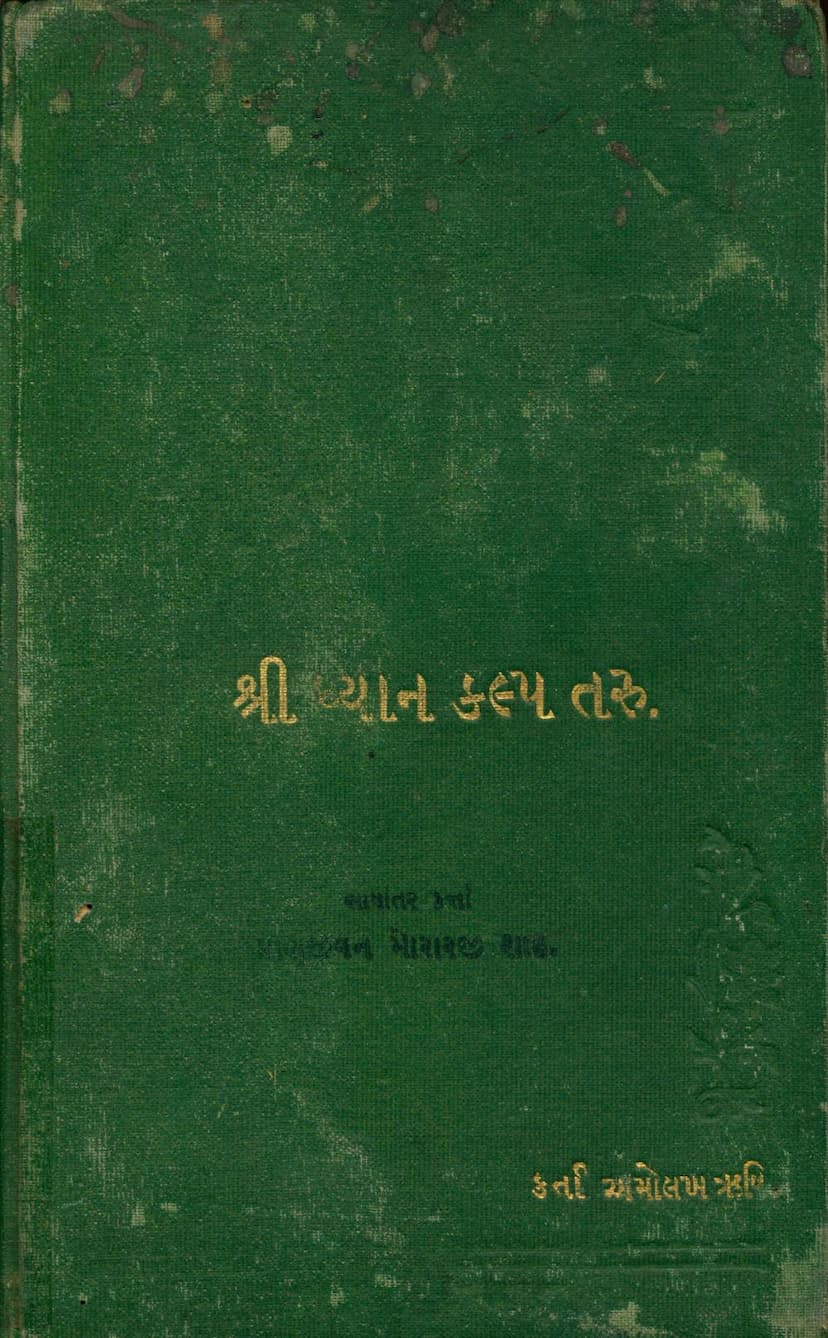Dhyan Kalptaru
Added to library: September 1, 2025

Summary
This comprehensive summary outlines the Jain text "Dhyan Kalptaru" (The Wish-Fulfilling Tree of Meditation), authored by Amolakrushi Maharaj and translated into Gujarati by Pranjivan Morarji Shah. Published in 1916, the book is presented as a guide to achieving ultimate spiritual liberation through meditation.
The text begins with a Manglacharan (auspicious invocation) and Bhumika (introduction), emphasizing the supreme nature of Shukla Dhyana (pure meditation) as practiced by Lord Mahavir, which led to the shedding of all karmas and the attainment of infinite knowledge, perception, conduct, and vigor, ultimately leading to Moksha (liberation).
The author highlights the prevalent state of unrest and excessive activity in modern times, where individuals are consumed by the pursuit of material possessions. This relentless pursuit leaves little room for spiritual contemplation, leading to dissatisfaction and regret even at the end of life. The text contrasts this with the peace and bliss attained by those who practice detachment, both internally and externally.
Dhyana (meditation) is identified as the direct, universally accepted, and fruit-bearing path to achieving the supreme bliss of Parmānanda (supreme joy). Meditation is defined as the concentration of the mind on a single object. The text outlines four types of meditation:
- Ārta Dhyana (sorrowful meditation) and Raudra Dhyana (fierce meditation) are considered detrimental and should be abandoned.
- Dharma Dhyana (righteous meditation) and Shukla Dhyana (pure meditation) are beneficial and should be cultivated.
The book then delves into the four types of meditation, elaborating on their nature, characteristics, and the fruits they yield:
I. Ārta Dhyana (Sorrowful Meditation):
- This is characterized by intense worldly desires and attachments.
- It is further divided into four types:
- Anishta Samyoga: Distress from the association of undesirable things or people.
- Ishta Viyoga: Grief from the separation from desirable things or people.
- Rogachikitsa: Suffering due to illness and the desire for healing.
- Bhogaichha: Craving for sensual pleasures and the inability to attain them.
- The characteristics of Ārta Dhyana include weeping, worrying, lamenting, and excessive attachment to worldly pleasures.
- The fruits of Ārta Dhyana are sorrow, the attainment of negative consequences, and rebirth in lower realms.
II. Raudra Dhyana (Fierce Meditation):
- This is marked by anger, cruelty, violence, and malice.
- It is also divided into four types:
- Himsanubandhi: Meditation focused on violence and causing harm to others.
- Mrushānubandhi: Meditation involving falsehood and deceit.
- Taskaranubandhi: Meditation focused on theft and acquisition through dishonest means.
- Samrakshanubandhi: Meditation aimed at protecting and hoarding possessions, often through unethical means.
- The characteristics include anger, hatred, jealousy, and a lack of compassion.
- The fruits of Raudra Dhyana lead to suffering, negative karma, and rebirth in hellish realms.
III. Dharma Dhyana (Righteous Meditation):
- This is the first of the two auspicious meditations.
- It is described as the path to cultivating virtues and understanding spiritual truths.
- The text emphasizes the importance of following the teachings of the Tirthankaras (Jain spiritual leaders) and understanding the principles of Jainism.
- Dharma Dhyana involves contemplation on:
- Ājnāvichaya: Understanding and adhering to the divine commands of the Tirthankaras.
- Apāyavichaya: Reflecting on the harmfulness of worldly attachments and negative emotions.
- Vipākavichaya: Contemplating the consequences of actions (karma) and their results.
- Sansthānavichaya: Meditating on the structure of the universe and the nature of existence.
- The text elaborates on the importance of understanding the subtleties of karma, the nature of the soul, and the path to liberation. It stresses the need for detachment from worldly possessions and sensory pleasures.
- It also details the path of virtue through adherence to the Pancha Mahavratas (five great vows) and the twelve vows for lay followers.
IV. Shukla Dhyana (Pure Meditation):
- This is the highest form of meditation, leading to the complete destruction of karma and liberation.
- It is described as a state of profound inner purity and spiritual realization.
- The text explains the four stages of Shukla Dhyana:
- Pruthaktva Vitarka: Differentiating between the soul and non-soul substances.
- Ekattva Vitarka: Achieving a state of oneness with the soul.
- Sukshma Kriya Apratipati: The subtle and unwavering nature of pure consciousness.
- Samuchhinnakriya Anivartin: Complete cessation of karmic activity and the attainment of liberation.
- The text highlights the characteristics of a Shukla Dhyani as being free from desires, anger, pride, deceit, greed, the five senses, and all worldly attachments. They are characterized by equanimity, detachment, and inner peace.
- The fruits of Shukla Dhyana are the attainment of omniscience, infinite bliss, and ultimate liberation.
The book also includes sections on Samyaktva (Right Faith/Belief), emphasizing its foundational role in Jainism and detailing its types and characteristics. It further discusses the importance of Shukla Dhyana in achieving Moksha (liberation) and the various virtues and practices that support this path.
The text concludes with an Upasamhar (conclusion), summarizing the journey of meditation from the lower forms of Ārta and Raudra Dhyana to the highest stages of Dharma and Shukla Dhyana. It reiterates that true happiness and liberation are found within, through the practice of meditation and the cultivation of virtuous qualities. The author expresses humility and offers the work for the benefit of all souls seeking spiritual upliftment.